I decided to write this article for the TBAS Aquarium Society Newsletter “the Filter”. Lots of people have been getting Bn’s from me and I figured I would let everyone know my methods of raising these catfish whether right or wrong. I have a certain degree of success raising these interesting catfish in my fish room. I have close to 100 tanks and most are fitted with Bn’s, either singly or multiple fish per tank. You can view my setup and fish room at “www.ronsaquatics.com. I figured I would publish it on my blog and the article so I could edit it and continue with it on a regular basis.
The Busy-nose Pleco Ancistrus, also known as the Bushy Nose Plecostomus, Bristlenose Plecostomus, comes from the rivers and tributaries of South America. It is mainly brown, with a mottling of lighter areas. The mouth area and nose are covered in short, whisker-like appendages, which are used for detecting food. There are also many color and fin variations available.
Bushy Nose Plecos make good additions to any community aquarium. The Busy-nose Pleco Ancistrus is by far one of the most popular fish in the aquarium hobby. It is easily attainable, easy to care for, useful and relatively active in the aquarium. This fish is one of the best algae eaters available on the market.
Most of the ones you see in the pet shops (LFS) are the Common Bristlenose Catfish or Ancistrus cf. cirrhosus. Most Ancistrus species come from South America, and range in the hundreds, with new species being discovered almost everyday, by collectors.
They are a very common species of catfish to have in your tank, usually for algae removal. They do not harm the vegetation and do an excellent job of removing unwanted algae and diatoms that build up on the glass. Bushynose also will not eat eggs of other fish or harm your fish if they so happen to run into them. They are not bottom feeders as most people think, they will clean the algae of the bottom rocks and substrate if it has grown out of control. If you happen to have a bare bottom tank, then they will clean it, just like the sides of your tank.
Planted aquariums with hearty, fast-growing plants, high aeration, and water movement make for a healthy environment. Rocks and driftwood help to accent a natural habitat and provide hiding spaces to cut down on stress for the Bushy Nose Plecostomus. A recommended minimum tank of 30 gallons should be provided to house this fish. The Bushy Nose Plecostomus is relatively easy to breed. The wild Busy-nose Pleco Ancistrus breeding occurs mostly in the winter months.
Ancistrus sp. Plecostomus Breeding
This Plecostomus can be triggered to breed in the late fall by performing a 75% water change. The eggs are usually deposited in a cave or crevice where the male will stay to guard them. He will stay with them fanning the eggs constantly. The female will leave after the eggs are laid. She will have no further contact with them just to inspect and check up on the male. The fry will become waterborne in approximately 10 days, at which time; they should be removed and raised in a separate aquarium. Feed the fry mashed, crushed flake food, or peeled peas.
All Ancistrus sp. are pretty easy to spawn. It takes a while for the fish to be sexually mature, six months or more, but they eventually should pair up. It is believed the spawn ratio of males to females in this fish is temperature sensitive. There is also a chance it is due to pH. Ancistrus Catfish (or Bristlenose) prefers to lay their eggs inside a clay pot. The eggs are stuck together in a clump. The male cares for the eggs, circulating the water over them.
My setup consist of 25 to 30 pairs of “Ancistrus sp. Bn’s”, either browns (Bn) Albino (Abn), Long-fin (BnV) Veil-tails, Super Reds (BnS), Calico’s (BnC), etc. there are many species of Ancistrus sp. Starting with L-numbers L-001 up to at least L-464 and many in between that have been discovered. The L system of numbering these catfish has been developed to replace the scientific names, until the species can be positively identified by DNA and scientific identification of the species. A lot of the Loricariids in the L-100 and up numbers are omnivores that eat more meaty foods and are not suitable “Algae” eaters. If you are looking for “Algae Eaters”, stick with the conventional and more common “Ancistrus species” Bn’ for that purpose. They are the best Algae eaters. Stay away from the larger Common Pleco’s and Flying Fox type fish for the will work well in the beginning but grow more rapidly and can attack you community fish.
My breeders Bn’s are paired up (1 Male and 1 Female) in individual 5.5 gallon tanks separate from the others in a rack of 18 tanks. They are all bare bottom and get thoroughly cleaned every one to three days depending on the detritus present on the bottoms. That also means they get a water change at the same time, some getting a 95 percent change, because of overly dirty water. Bn’s in quantity tend to foul the water pretty regularly, but can tolerate that ammonia ridden water, better than any fish I have seen. All tanks are equipped with a Pro-Series Sponge filter, painted back sides and bottom and a Ceramic cave.
Most Bn’s will not spawn unless some form of cave is present. The type of cave is critical to the fish spawning. I use the commercially available ceramic caves made usually for “African Cichlids”. A lot of breeders use Slate caves that are built as square chambers with or without one end closed or clay fired caves built as a tube with one end pinched off.
These straight caves I have found can be death traps for the larger BN males. When there ontodonts (multiple spiny bristles located on the sides of the Bn’s near the pectoral fins) are activated, they can only go one way in the tube and that is forward, it acts as “Chinese cuff-links” in that the fish will get struck and without help to get out can die in the tube of the cave. I find that the small ceramic caves work best because there will be less chances of the Large BN males getting stuck and dying in the cave. The opening inside the cave needs to be larger than the opening outside, so the male Bn, can turn around inside the cave and exit head first. The straight Slate and Clay Caves do not provide this outlet. I have even had to cut out some Bn’s that packed in the cave so tight that they couldn’t get out, breaking the ceramic cave and removing the fish with tweezers sometimes. I also use medium ceramic caves for some of the largest males in my entourage of Bn’s.
The cave must provide closure for the fertilization of the eggs. It also must enclose the sperm inside the cave; so long enough contact with the eggs provides good fertilization. End open slate caves and PVC pipe caves with two open ends do not provide for this contact time, as flow through the open end caves dilutes the sperm and its contact time.
It also provides a place for the eggs to be protected by the male as he fans, clean oxygenated water over the eggs until they hatch. Once they do hatch the small yellow yolk sacked larvae must stay within the cave to prevent them from getting eaten by predators or other tank mates. Once they color up they become free swimming and start to exit the cave slowly to explore there surrounding and look for food. The tank glass usually provides there first food source in the form of algae growth just starting to regrow. I then feed both a high quality flake food and “Algae wafers” as a food source. They are usually fed daily and (1) skip day once per week, which helps keep the tanks clean by cleaning up any residual food from the tanks surface, detritus and glass.
Sometime the male BN’ will kick the eggs out of the cave. I have found this is due to immaturity of the male, infertility of the eggs, too many spawns within a short period and the male already still raising as many as 3 broods at once. I do not remove the females from the tank and sometimes the females will lay as many as 3 batches of eggs, forcing the male to care for many more Bn’s than he would like too. So he kicks them out into the main tank. When I see these extra eggs I remove them to a breeder trap in my Cory’s grow out area. I hatch them and raise them up as if they were in a cave. The breeder trap provides water flow, protection, and allows the larvae to color up and become free swimming Bn’s. The young Bn’s are removed to grow out, ten gallon tanks, with the entire spawn release to each tank. There can be as little as 50 and as many as 200 young in each grow out tank. With 50 to 200 eggs with each spawn, and 25 breeder tanks with different ages of Bn’s present in grow out tanks, I easily have 1000 to 2000 Bn varieties of fry available at all times.
Ancistrus sp. Plecostomus Feeding
Ancistrus cf. and A. cirrhosus is an herbivore. Most authorities consider Ancistrus sp. in the wild are omnivores, but in the tank they like eating a vegetarian fare. Some species have even been found to eat the small Malaysian trumpet snails.
Feeding the Bushy Nose Plecostomus is not difficult due to the fact that it is not a picky eater. They feed off the bottom of the aquarium, the sides of the glass and the algae that grows throughout the tank. It gets most of its nutrition from removing the fine layer that grows back on the tank glass night after night. I will also eat some left over food. Algae wafers should be feed on a regular basis as a supplement for good health and nutrition. You should give it a diet of spirulina wafers, and other vegetable matter. They are also scavengers, and will eat uneaten food. As a treat you can offer them zucchini once a week, which they really enjoy.
Ancistrus sp. Plecostomus Algae Controllers
The tanks that I don’t have Bn’s in are rampant with “Algae” either green or “brown Diatoms” covering the glass. I usually clean the fronts with an algae scrubber, but the back of the tanks are loaded with it. I have some catfish that require algae including the Bn’s but most, and I do say most of the tanks with Bn’s in them are clean as a “whistle”. “Why” you say because the Bn’s clean them off every night after lights out. They methodically clean every inch of a 10 gallon aquarium every two to three days. The will also clean your plants, very carefully not hurting the plants being equipped with a very special set of rasping teeth, they carefully clean off all algae growing on your plants. They will not hurt your plants or any of your other fish present in the tank. They have a long gut (intestine) suitable only for vegetable matter and consume it in great quantities. They also eat the lignin of any driftwood that may and should be present in your tanks. Many species of “Ancistrus” and “Loricariidae” catfish require wood in there diets. Most all of mine have some form of it present during grow out form, in the tanks. For a good article on the types of algae and control you can go to http://www.aquahobby.com/articles/e_freshwater_algae.php
Bristlenose Plecos are really easy to care for. They accept pretty hard, basic water, and do fine in soft, acidic water. The tank should be good sized, with caves and tight crevices for the fish to hide in.
Wikipedia List currently 66 recognized species in this genus while Planet Catfish recognizes 299 including L-numbers. You will find there listinmgs at the end of this article.
There are four main species of ancistrus busynose plecos, found in the trade and they are as follows:
Ancisrrus sp.
Ancisrrus sp. L144
Ancistrus cirrhosus
Ancistrus cf. cirrhosus
Ancistrus temminckii
Most experts consider these fish to have been crossed or the current species are crossed and the information on them is blurred just like most aquarium strains.
This article is not about all the different ancistrus, but the varieties of the the Common Brown ancistrus that occur in nature. Planet catfish does not approve of any variety designation for Ancistrus sp. Varieties are out there and more common than the wild or L-Number species that have been designated a scientific name.
Planet Catfis considers them hybrids, crosses or mutants of regular species. No one is totaklly sure of the origins or development of each variety, so I will just run over as many as I can find to give you a synopsis of the different vaieties of Ancistus sp. A lot of prople with Ancistrus confuse Stress colouration in Ancistrus cf. cirrhosus, with the Calici, Mottled or Piebold gene, there is a difference.
WE will be concentrating on the main four species in this article. This is my starin designation as to varieties. I will probably get some of this wrong, but corrections are welcome, and I will try my best to accomidate any edits that are submitted.
Scientific Name: Ancistrus sp.
Variety Name Designation:
Bristlenose Pleco Color Gene
- BrBn, Brown Bristlenose Pleco
- BlkBn, Black Bristlenose Pleco
- Abn1, Albino Bristlenose Pleco
- Abn2, Albino Bristlenose Pleco
- YlBnBlu, Yellow-Ancistrus Blue-eye Bristlenose Pleco
- YlBnBk, Yellow-Ancistrus Black-eye Bristlenose Pleco
- CaBn, Calico Bristlenose Pleco
- OrBn, Orange Bristlenose Pleco
- PbBn, Piebald Bristlenose
- SrBn, Super Red Bristlenose Pleco
- GdBn, Green Dragon Bristlenose Pleco
- Finage Genes
- BnLf, Long-fin Bristlenose Pleco Gene
- ABnLf, Albino Long-fin Bristlenose Pleco
- BrBnLf, Brown Long-fin Bristlenose Pleco
- VtBn, Veiltail Bristlenose Pleco Gene
- AbVBn, Albino Veiltail Pleco
- BrVbn, Brown Veiltail Pleco
- GdBn, Green Dragon Veiltail Pleco
Common Brown Bushynose
The Common Brown Bushynose is the wild type fish coloration originating from South America, but some authorities will dispute that it is a wild type species at all.
BrBn, Brown Bristlenose Pleco:
Black Bristlenose Pleco:
Albino Bristlenose Pleco
The Albino Gold Bushy Nose Pleco, also known as the Yellow-Ancistrus, comes from the Amazon Basin of South America. The albino Bristlenose pleco is not a species of fish, it is only an albino version of the common Bristlenose pleco. Albinism is a naturally occurring phenomenon in the wild, but since albino fish lack protective camouflage they are normally eaten by predators at a young age. In an aquarium without any predators, the albino Bristlenose pleco can become just as old as the non-albino Bristlenose pleco. A lot of aquarists appreciate albino versions of fish and the albino Bristlenose pleco is therefore highly sought after in the aquarium trade.
ABn1 Albino Bristlenose Pleco:
Albinism is not only found in fishes, it affects mammals, amphibians, reptiles and birds as well. In an albino Bristlenose pleco, the body cannot produce the normal amounts of the pigment melanin. Albino Bristlenose pleco wants the same conditions and care as the normal Bristlenose pleco, i.e. a water temperature of 22-27 degrees C (71-80 degrees F) and a pH-value between 5.8 and 7.0.
That is why when two Albino’s are bred together and the procuce all brown off spring it means there are two mechanisms for the production of albinos in ancistrus. Therefore there are two different types of Albino Bristlenose Plecos! Each has the albino gene in a different location. This is why it is possible to have a pair of Albino bristlenose produce a 100% non-albino types.
Albino crossed with an albino will result in generally 100% albino fry. The reasoning behind this is that the albino gene is recessive and therefore if you have an albino fish it must have two copies of the albino gene meaning that the only color morph genes the fry can get is albinos.
ABn2 Albino Gold Bristlenose Pleco:
This is the second albino gene that produces albino bristlenose. To complicate this, we probably have two different Albino genes in our bristlenose. On occasion we will get browns out of an Albino pair. We have designated them as Abn2.
YlBnBlu, Yellow-Ancistrus Blue eyes Bristlenose Pleco:
Yellow or leucistic anicstrus is created by a third lightening gene. Wikipedia defines Leucistic as “Leucism as a condition in which there is partial loss of pigmentation in an animal resulting in white, pale, or patchy coloration of the skin, hair, feathers, scales or cuticle, but not the eyes. Unlike albinism, it is caused by a reduction in multiple types of pigment, not just melanin.
The Blue Eyes seem to be quite a bit more difficult to get spawning.
The L144 that is commonly sold in shops today is very unlikely to be the true L144. There was an original L144 which was a male, it was initially bred with females of it’s same species (different than commons) until the L144 line was developed. Somewhere along time, either the L144 line was bred into the common line or a similar mutation developed in the common line. However, the original L144 line was believed to be a singlular species while the “new” L144 are L144xCommon hybrids or Leucistic Commons.
YlBnBk – Black-eyed Yellow Bristlenose (Ancistrus sp. L144):
CaBn, Calico Bristlenose Pleco:
OrBn, Orange Bushy Nose Pleco:
The Orange Bushy Nose Pleco is a variation that is orange with darkbrown or black markings. These plecos will darken with age, as well as gain whiskers on the nose.
Calico crossed with calico will give 100% calico, Calico crossed with albino will give 100% calico and calico crossed with common will give a 50/50 split of common and calico. If you have cross bred parents then this will vary markedly.
PbBn, Piebald or Marble Bristlenose Pleco:
SrBn, Super Red Bristlenose Pleco:
The super red line came from the albino type 2 line as far as I can tell form my reading and asking a round. Basically they bred the ones with most pink/red on them until the entire fish was covered in red. That’s the basic version anyway. Super reds are one of the fish I would suggest getting a breeding pair rather than crossing. This goes for the green and blue lines as well. While these will interbreed I suggest that the crosses will product mostly common or albino fry as the red, green or blue colour is going to be very recessive and easily covered but covered by the more prevalent albino or common…or even calico gene. This species was known as Ancistrus sp (3) in the Cat-eLog from February 1997 until August 2008, it will likely still commonly be referred to under this name for some time and even its current designation is a little tentative. For these reasons we’ve left “sp(3)” as a common name. Several colour forms exist as well a long fin strain. The super-red form was first line-bred from the calico form of the common bristlenose in Germany. As is the way with the common bristlenose, they are pretty fertile and as soon as the pure strain got introduced into the market, it quickly spread across Europe and over the Atlantic. A long-finned variety was also line-bred from them relatively soon after that. There is some variation in the quality of the strain, a good strain produces 100% all-red offspring, less-than-optimal breeding stock (even if they are all-red) can produce a fair amount of offspring with some residual black markings.
GdBn, Green Dragon Bristlenose Pleco: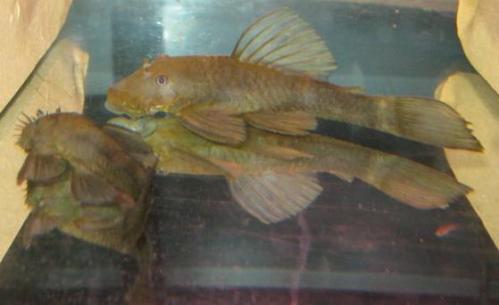
Green dragons are a line bred strain of the common bristlenose. It was originated by a female that showed fewer, and smaller, light areas and was line bred till the spots just went away.
Long-fin Bristlenose Pleco Dominant Gene
The long fin gene in most fish, including Plecos, is a dominant gene. If you buy plecos with normal fins, they do not and cannot have the long fin gene. If both parents are long fin and carry the normal fin gene, 75% of the fry will have long fins and 25% will have normal fins. 33% of the longfin fry will carry only longfin genes and 66% of the longfin fry will carry both the long fin and normal fin genes. All the normal fin fry will carry only normal fin genes.If either or both parents carries only the long fin gene, all fry will all be long fin.
Truely, I simplified the issue as there are more than 2 genes that may determine the longfin trait. The only way you can say a short fin pleco carries the longfin gene is if you have spawned one of the parents with another partner and all the fry were long fin and then you spawned it with another long fin and there were some normal fin fry. The only realistic way to know what a fish is capable of producing is to breed it with a fish that is absolutely known. Longfin in bristlenose plecos may not just be a single gene.
Long-fin Bristlenose Pleco Dominant Gene
The long fin gene in most fish, including Plecos, is a dominant gene. If you buy plecos with normal fins, they do not and cannot have the long fin gene. If both parents are long fin and carry the normal fin gene, 75% of the fry will have long fins and 25% will have normal fins. 33% of the longfin fry will carry only longfin genes and 66% of the longfin fry will carry both the long fin and normal fin genes. All the normal fin fry will carry only normal fin genes.If either or both parents carries only the long fin gene, all fry will all be long fin.
Truely, I simplified the issue as there are more than 2 genes that may determine the longfin trait. The only way you can say a short fin pleco carries the longfin gene is if you have spawned one of the parents with another partner and all the fry were long fin and then you spawned it with another long fin and there were some normal fin fry. The only realistic way to know what a fish is capable of producing is to breed it with a fish that is absolutely known. Longfin in bristlenose plecos may not just be a single gene.
BnLf, Long-fin Bristlenose Pleco: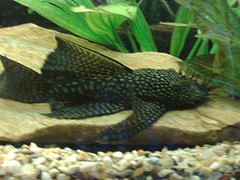
GdBn, Long-fin Green Dragon Bristlenose Pleco:
ABnLf, Albino Long-fin Bristlenose Pleco: The Albino Long Fin Pleco comes from the riversand tributariesof Paraguay. They are pale in coloration with very long flowing fins. Like other albino fish, these plecos have the signature red eyes. Longfin is a dominant charachteristic, therefore only a pair that includes one longfin parent can produce longfins. Standard finned bristlenose, when paired together, cannot produce longfins under any circumstance.
VtBn, Veiltail Bristlenose :
Extra long fins as to longfin pleco
AbVBn, Albino Veiltail Pleco:
Albino version of the Veiltail Bristlenose Pleco.
Most of the pictures in this article are from the internet Google search. I give credit to all who published the pictures and if I have used a picture that someone does not want me too just email me and I will remove or replace it. None of them had a copy write symbol or name on them so I think I am safe.
Ron Bows
Wikipedia Listing Ancistrus Species
- Ancistrus abilhoai Bifi, Pavanelli & Zawadzki, 2009
- Ancistrus agostinhoi Bifi, Pavanelli & Zawadzki, 2009
- Ancistrus aguaboensis Fisch-Muller, Mazzoni & C. Weber, 2001
- Ancistrus bodenhameri L. P. Schultz, 1944
- Ancistrus bolivianus (Steindachner, 1915)
- Ancistrus brevifilis C. H. Eigenmann, 1920
- Ancistrus brevipinnis (Regan, 1904)
- Ancistrus bufonius (Valenciennes, 1840)
- Ancistrus caucanus Fowler, 1943
- Ancistrus centrolepis Regan, 1913
- Ancistrus chagresi C. H. Eigenmann & R. S. Eigenmann, 1889
- Ancistrus cirrhosus (Valenciennes, 1836) (Jumbie teta)
- Ancistrus claro Knaack, 1999
- Ancistrus clementinae Rendahl (de), 1937
- Ancistrus cryptophthalmus R. E. dos Reis, 1987
- Ancistrus cuiabae Knaack, 1999
- Ancistrus damasceni (Steindachner, 1907)
- Ancistrus dolichopterus Kner, 1854 (Bushymouth catfish)
- Ancistrus dubius C. H. Eigenmann & R. S. Eigenmann, 1889
- Ancistrus erinaceus (Valenciennes, 1840)
- Ancistrus eustictus (Fowler, 1945)
- Ancistrus falconensis Taphorn, Armbruster & Rodríguez-Olarte, 2010
- Ancistrus formoso Sabino & Trajano, 1997
- Ancistrus fulvus (Holly, 1929)\Ancistrus galani A. Pérez & Viloria, 1994
- Ancistrus gymnorhynchus Kner, 1854
- Ancistrus heterorhynchus (Regan, 1912)
- Ancistrus hoplogenys (Günther, 1864)
- Ancistrus jataiensis Fisch-Muller, A. R. Cardoso, J. F. P. da Silva & Bertaco, 2005
- Ancistrus jelskii (Steindachner, 1877)
- Ancistrus latifrons (Günther, 1869)
- Ancistrus leucostictus (Günther, 1864)
- Ancistrus lineolatus Fowler, 1943
- Ancistrus lithurgicus C. H. Eigenmann, 1912
- Ancistrus macrophthalmus (Pellegrin, 1912)
- Ancistrus maculatus (Steindachner, 1881)
- Ancistrus malacops (Cope, 1872)
- Ancistrus maracasae Fowler, 1946
- Ancistrus martini L. P. Schultz, 1944
- Ancistrus mattogrossensis A. Miranda-Ribeiro, 1912
- Ancistrus megalostomus N. E. Pearson, 1924
- Ancistrus minutus Fisch-Muller, Mazzoni & C. Weber, 2001
- Ancistrus montanus (Regan, 1904)
- Ancistrus mullerae Bifi, Pavanelli & Zawadzki, 2009
- multispinis (Regan, 1912)
- Ancistrus nudiceps (J. P. Müller & Troschel, 1849)
- Ancistrus occidentalis (Regan, 1904)
- Ancistrus occloi C. H. Eigenmann, 1928
- parecis Fisch-Muller, A. R. Cardoso, J. F. P. da Silva & Bertaco, 2005
- pirareta So. Muller, 1989
- Ancistrus piriformis So. Muller, 1989
- ranunculus So. Muller, Rapp Py-Daniel & Zuanon, 1994
- Ancistrus reisi Fisch-Muller, A. R. Cardoso, J. F. P. da Silva & Bertaco, 2005
- Ancistrus salgadae Fowler, 1941
- Ancistrus spinosus Meek & Hildebrand, 1916 – recognized by FishBase, but a synonym of A. centrolepis.
- Ancistrus stigmaticus C. H. Eigenmann & R. S. Eigenmann, 1889
- Ancistrus tamboensis Fowler, 1945
- Ancistrus taunayi A. Miranda-Ribeiro, 1918
- Ancistrus temminckii (Valenciennes, 1840)
- Ancistrus tolima Taphorn, Armbruster, Villa-Navarro & C. K. Ray, 2013
- Ancistrus tombador Fisch-Muller, A. R. Cardoso, J. F. P. da Silva & Bertaco, 2005
- Ancistrus trinitatis (Günther, 1864)
- Ancistrus triradiatus C. H. Eigenmann, 1918
- Ancistrus variolus (Cope, 1872)
- Ancistrus verecundus Fisch-Muller, A. R. Cardoso, J. F. P. da Silva & Bertaco, 2005
- Ancistrus vericaucanus Taphorn, Armbruster, Villa-Navarro & C. K. Ray, 2013
There are different species of busy nose catfish. Planet Catfish list about 150 known species, including L numbers that have not been given a scientific name, because they have not been officially identified and described yet.





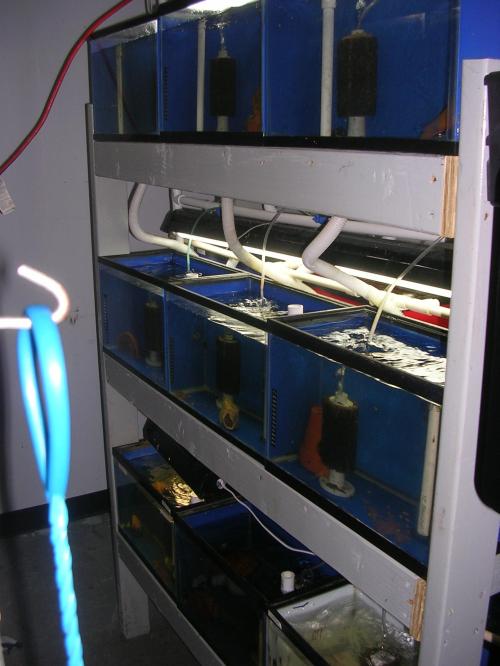
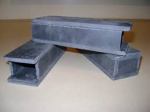

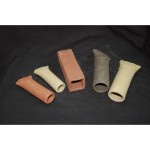
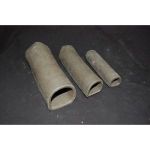
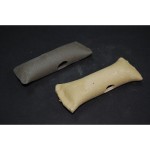





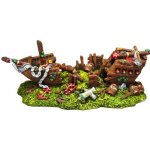

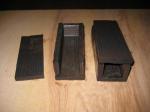






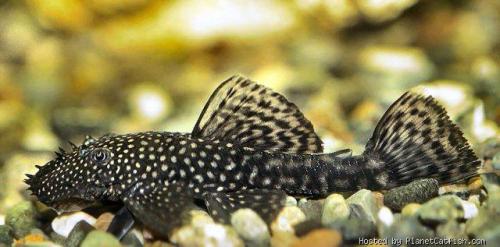
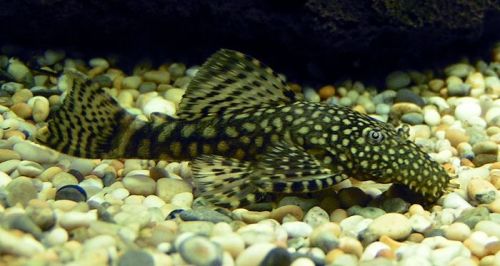
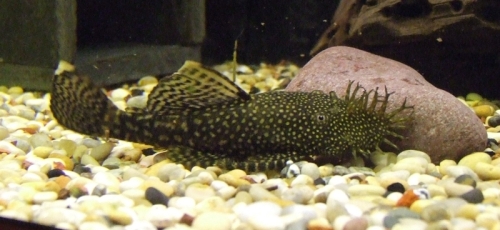
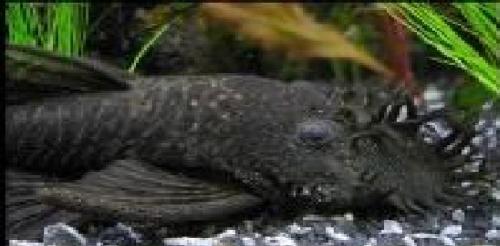
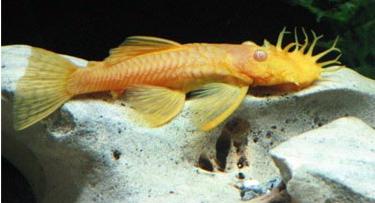
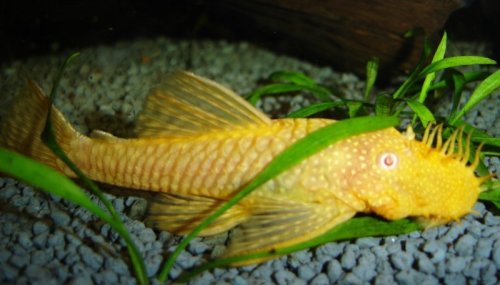
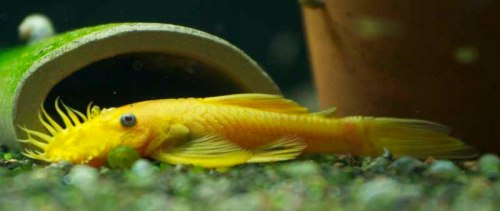
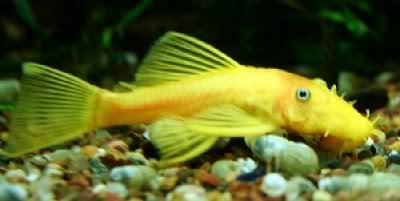
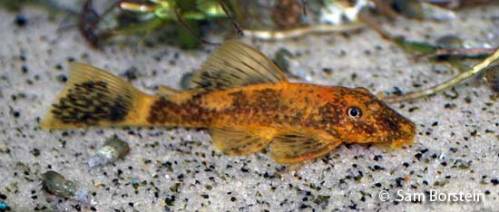
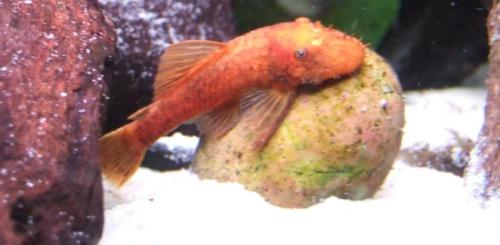
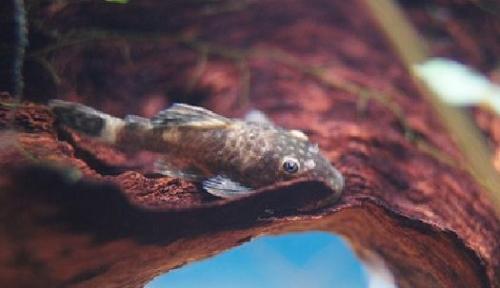
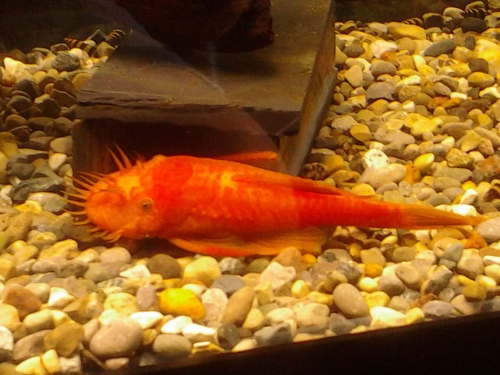
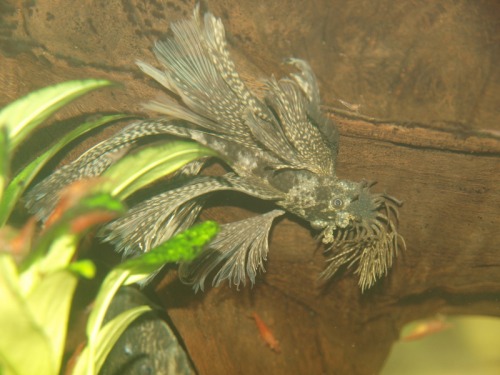
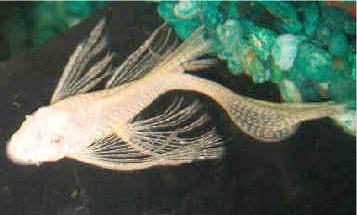


Great post . You should send it in as an article for the news letter. Lots of good information . Bill
It was already in January’s Filter by TBAS! Not all of it but some of the stuff on how I breed them. There is a lot more here.